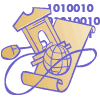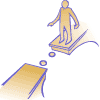What are some simple ways to get started?

As you introduce constructivist theory into your classroom, don't expect grand results at the start. A single trial unit added to the curriculum you are already teaching can only begin to hint at the potential for students' knowledge creation. Here are twelve strategies:
 . Encourage
and accept student autonomy and initiative. This is one of the
ways that we motivate students to take charge of their own learning.
But guide them through the process of creating meaningful activities,
assessments, and so on.
. Encourage
and accept student autonomy and initiative. This is one of the
ways that we motivate students to take charge of their own learning.
But guide them through the process of creating meaningful activities,
assessments, and so on.
You can try activities like setting up a constructivist learning situation -- inviting students to bring in recyclable bottles for a science project -- or welcoming their proposals of alternative theories.
 . Use raw data
and primary sources, along with manipulative, interactive, and
physical materials.
. Use raw data
and primary sources, along with manipulative, interactive, and
physical materials.
 Prime
the discovery process by providing math manipulatives, appropriate
computer software, etc. But also introduce developmentally appropriate
ways to collect and track information.
Prime
the discovery process by providing math manipulatives, appropriate
computer software, etc. But also introduce developmentally appropriate
ways to collect and track information.
Community resources such as historical sites, local speakers in different fields of expertise, museums, all provide opportunities for students to collect and classify primary material. Historical societies and libraries may have historical documents to view.
Web sites are becoming increasingly valuable. The Library of Congress American Memory project, for instance, gives students access to primary sources. Students can find digitized historical photographs, eyewitness accounts, diaries, journals, and artwork there, and can therefore readily incorporate them into demonstrations of knowledge.
While predigested information (textbooks, workbooks, and the like) may be valuable, they demonstrate someone else's construction of knowledge, not your students'.
 . When framing
tasks, use cognitive terminology such as "classify," "analyze,"
"predict," and "create." This language opens up the opportunities
for students to explore learning. Take it slowly and step-by-step.
. When framing
tasks, use cognitive terminology such as "classify," "analyze,"
"predict," and "create." This language opens up the opportunities
for students to explore learning. Take it slowly and step-by-step.
 . Allow student
responses to drive lessons, shift instructional strategies, and
alter content.
. Allow student
responses to drive lessons, shift instructional strategies, and
alter content. 
Do not misinterpret this to mean all lessons should be popular. But a universal blank stare from students after you thought you had told a perfectly apt metaphorical story may mean you need to reshape the way you bridge from your students' already existing knowledge to what you want them to construct.
 . Inquire about
students' understanding of concepts before sharing your own understandings
of those concepts.
. Inquire about
students' understanding of concepts before sharing your own understandings
of those concepts.
Wait before you say, "Inertia is the tendency of an object to remain at rest or to remain in motion unless acted upon by an outside force." It may be more meaningful after students prepare for the concept by playing and then discussing a game of soccer -- what happened to the ball, what happened when players ran into each other, and so forth.
 . Encourage
students to engage in dialogue, both with you and with one another.
. Encourage
students to engage in dialogue, both with you and with one another.
In a traditional classroom, dialogue is often discouraged. Teachers often monopolize the talking, and the monologue takes the form of lecturing. Switching from a traditional approach to a constructivist one means breaking this habit.
Learners formulate concepts through dialogues in the classroom. Students should be encouraged to engage in dialogue during class discussions. Group work should be organized to facilitate dialogue. Dialogue can be extended by electronic means such as e-mail or online conferencing.
 . Prompt student
inquiry by asking thoughtful, open-ended questions and encouraging
students to ask questions of each other.
. Prompt student
inquiry by asking thoughtful, open-ended questions and encouraging
students to ask questions of each other.
 You
should monitor group working and peer-editing situations to ensure
that productive dialogue is taking place. Model how students can
learn from each other. "That interests me," "I didn't think about
it that way," and "Can you tell me more?" are the kinds of encouragement
that model constructivist coaching.
You
should monitor group working and peer-editing situations to ensure
that productive dialogue is taking place. Model how students can
learn from each other. "That interests me," "I didn't think about
it that way," and "Can you tell me more?" are the kinds of encouragement
that model constructivist coaching.
 . Seek elaboration
of students' initial responses.
. Seek elaboration
of students' initial responses.
Draw students out. This is particularly crucial for those who are shy or inarticulate.
You may find that using e-mail and conferencing to extend class discussions is valuable. Studies show that most of the time, in the electronic forum, gender- and racial-based biases no longer deter the free discourse necessary to good learning.
 . Engage students
in experiences that might engender contradictions to their initial
hypotheses, and then encourage discussion.
. Engage students
in experiences that might engender contradictions to their initial
hypotheses, and then encourage discussion.
This is an effective technique for the constructivist teacher when confronted with deeply held convictions or a complex concept (such as research-paper writing) that needs to be unfolded.
As students experience situations that test their understanding, they revise and strengthen their knowledge.

 . Allow "wait
time" after posing questions.
. Allow "wait
time" after posing questions.
Provide ample time for thinking during class discussion. (This goes hand-in-hand with learning to frame questions so that there is no single right answer.)

 .
Provide time for students to construct relationships and create
metaphors.
.
Provide time for students to construct relationships and create
metaphors.
And, model how to construct relationships and metaphors. An English teacher, for example, might wish to show an author's rough drafts in addition to the finished novel. This will provide students insight into the writer's creative processes. First-person accounts of people from many fields may help students see the value that time and reflection have in knowledge building. You may wish to invite a local writer or scientist to visit the class.


 .
Nurture students' natural curiosity through frequent use of the
three-step Learning Cycle model: Discovery, Concept Introduction,
and Concept Application. The Learning Cycle is a design that can
be used as a general framework for many kinds of constructivist
activities. It is discussed more fully in the Implementation section
of this workshop.
.
Nurture students' natural curiosity through frequent use of the
three-step Learning Cycle model: Discovery, Concept Introduction,
and Concept Application. The Learning Cycle is a design that can
be used as a general framework for many kinds of constructivist
activities. It is discussed more fully in the Implementation section
of this workshop.